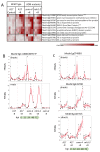A Medicago truncatula Autoregulation of Nodulation Mutant Transcriptome Analysis Reveals Disruption of the SUNN Pathway Causes Constitutive Expression Changes in Some Genes, but Overall Response to Rhizobia Resembles Wild-Type, Including Induction of TML1 and TML2
- PMID: 37367042
- PMCID: PMC10297080
- DOI: 10.3390/cimb45060293
A Medicago truncatula Autoregulation of Nodulation Mutant Transcriptome Analysis Reveals Disruption of the SUNN Pathway Causes Constitutive Expression Changes in Some Genes, but Overall Response to Rhizobia Resembles Wild-Type, Including Induction of TML1 and TML2
Abstract
Nodule number regulation in legumes is controlled by a feedback loop that integrates nutrient and rhizobia symbiont status signals to regulate nodule development. Signals from the roots are perceived by shoot receptors, including a CLV1-like receptor-like kinase known as SUNN in Medicago truncatula. In the absence of functional SUNN, the autoregulation feedback loop is disrupted, resulting in hypernodulation. To elucidate early autoregulation mechanisms disrupted in SUNN mutants, we searched for genes with altered expression in the loss-of-function sunn-4 mutant and included the rdn1-2 autoregulation mutant for comparison. We identified constitutively altered expression of small groups of genes in sunn-4 roots and in sunn-4 shoots. All genes with verified roles in nodulation that were induced in wild-type roots during the establishment of nodules were also induced in sunn-4, including autoregulation genes TML2 and TML1. Only an isoflavone-7-O-methyltransferase gene was induced in response to rhizobia in wild-type roots but not induced in sunn-4. In shoot tissues of wild-type, eight rhizobia-responsive genes were identified, including a MYB family transcription factor gene that remained at a baseline level in sunn-4; three genes were induced by rhizobia in shoots of sunn-4 but not wild-type. We cataloged the temporal induction profiles of many small secreted peptide (MtSSP) genes in nodulating root tissues, encompassing members of twenty-four peptide families, including the CLE and IRON MAN families. The discovery that expression of TML2 in roots, a key factor in inhibiting nodulation in response to autoregulation signals, is also triggered in sunn-4 in the section of roots analyzed, suggests that the mechanism of TML regulation of nodulation in M. truncatula may be more complex than published models.
Keywords: Medicago truncatula; RDN1; SUNN; TML; autoregulation of nodulation; small secreted peptides.
Conflict of interest statement
The authors have declared that no competing interests exist for this research work. Leidos and the non-profit Sage Bionetworks have no competing interests for this research work.
Figures







Similar articles
-
Mutation of BAM2 rescues the sunn hypernodulation phenotype in Medicago truncatula, suggesting that a signaling pathway like CLV1/BAM in Arabidopsis affects nodule number.Front Plant Sci. 2024 Jan 11;14:1334190. doi: 10.3389/fpls.2023.1334190. eCollection 2023. Front Plant Sci. 2024. PMID: 38273950 Free PMC article.
-
Multiple Autoregulation of Nodulation (AON) Signals Identified through Split Root Analysis of Medicago truncatula sunn and rdn1 Mutants.Plants (Basel). 2015 Apr 27;4(2):209-24. doi: 10.3390/plants4020209. Plants (Basel). 2015. PMID: 27135324 Free PMC article.
-
CLE peptide tri-arabinosylation and peptide domain sequence composition are essential for SUNN-dependent autoregulation of nodulation in Medicago truncatula.New Phytol. 2018 Apr;218(1):73-80. doi: 10.1111/nph.15019. Epub 2018 Feb 2. New Phytol. 2018. PMID: 29393515
-
Leguminous plants: inventors of root nodules to accommodate symbiotic bacteria.Int Rev Cell Mol Biol. 2015;316:111-58. doi: 10.1016/bs.ircmb.2015.01.004. Epub 2015 Feb 20. Int Rev Cell Mol Biol. 2015. PMID: 25805123 Review.
-
Progress in the Self-Regulation System in Legume Nodule Development-AON (Autoregulation of Nodulation).Int J Mol Sci. 2022 Jun 15;23(12):6676. doi: 10.3390/ijms23126676. Int J Mol Sci. 2022. PMID: 35743118 Free PMC article. Review.
Cited by
-
TML1 and TML2 synergistically regulate nodulation and affect arbuscular mycorrhiza in Medicago truncatula.Front Plant Sci. 2024 Dec 11;15:1504404. doi: 10.3389/fpls.2024.1504404. eCollection 2024. Front Plant Sci. 2024. PMID: 39722877 Free PMC article.
-
The Defective in Autoregulation (DAR) gene of Medicago truncatula encodes a protein involved in regulating nodulation and arbuscular mycorrhiza.BMC Plant Biol. 2024 Aug 10;24(1):766. doi: 10.1186/s12870-024-05479-6. BMC Plant Biol. 2024. PMID: 39123119 Free PMC article.
-
Laser Capture Microdissection Transcriptome Reveals Spatiotemporal Tissue Gene Expression Patterns of Medicago truncatula Roots Responding to Rhizobia.Mol Plant Microbe Interact. 2023 Dec;36(12):805-820. doi: 10.1094/MPMI-03-23-0029-R. Epub 2023 Dec 23. Mol Plant Microbe Interact. 2023. PMID: 37717250 Free PMC article.
-
Ethylene biosynthesis in legumes: gene identification and expression during early symbiotic stages.J Exp Bot. 2025 Jul 2;76(10):2659-2672. doi: 10.1093/jxb/eraf069. J Exp Bot. 2025. PMID: 39969186 Free PMC article.
-
Mutation of BAM2 rescues the sunn hypernodulation phenotype in Medicago truncatula, suggesting that a signaling pathway like CLV1/BAM in Arabidopsis affects nodule number.Front Plant Sci. 2024 Jan 11;14:1334190. doi: 10.3389/fpls.2023.1334190. eCollection 2023. Front Plant Sci. 2024. PMID: 38273950 Free PMC article.
References
-
- Crawford N.M., Kahn M.L., Leustek T., Long S.R. Nitrogen and sulfur. In: Buchanan B.B., Gruissem W., Jones R.L., editors. Biochemistry and Molecular Biology of Plants. American Association of Plant Physiologists; Rockville, MD, USA: 2000. pp. 787–849.
Grants and funding
LinkOut - more resources
Full Text Sources

